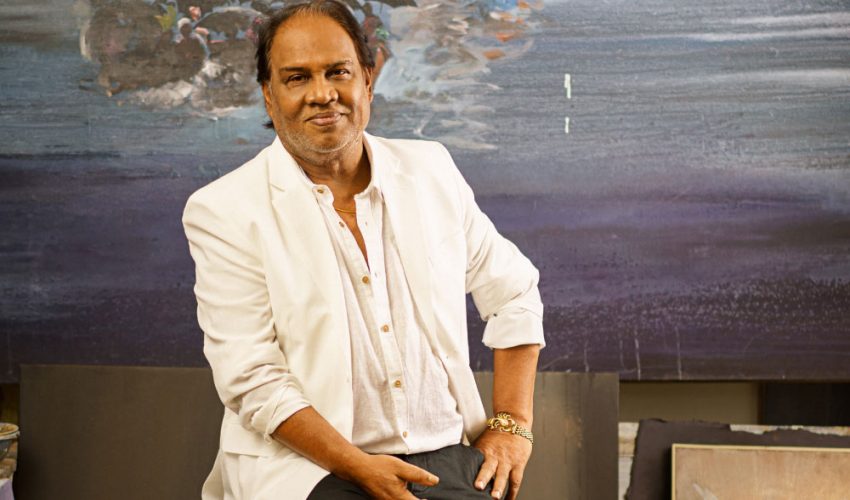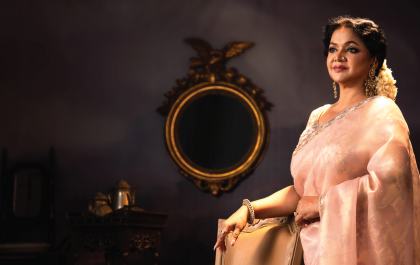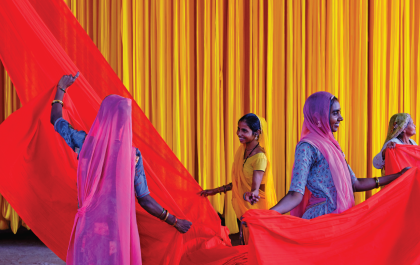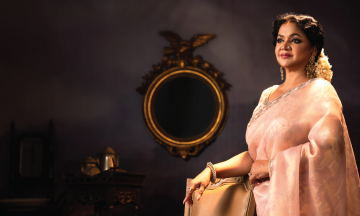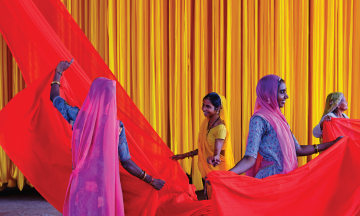By Sabrina Fatma Ahmad
Getting candid with Jamal Uddin Ahmed
He tells us about that one time he had to buy back a painting he had lost en route to delivering it to a client. “My client had commissioned a large painting that she was going to unveil at a soiree organized around the art. It was too large to fit inside my car, so I strapped it to the roof, and we drove off to deliver it on a windy day. We had already arrived at the client’s house when we discovered that the painting was missing. The tethers must have come loose at some point and the painting flew off” he reminisces with a chuckle. “So now I have a client in tears, and I have to calm her down. My driver is frantically retracing our steps, trying to find the painting. He ended up discovering it with a security guard, who had already pulled the canvas off the frame and rolled it up, and was in the middle of chopping up the frame for firewood. He had realized that the painting had some value, and refused to part with it for free. So we offered him a generous chunk of money, and thankfully got the piece back in time for the event. But imagine; I had to pay money to get my own painting back!” he exclaims, with a deep belly laugh.
You go to Jamal Uddin Ahmed for the art, but you stay for the stories. Man’s World Bangladesh recently had the pleasure of a lengthy tete-a-tete with the Ekushey Padak winning artist.
“Jamal consciously refuses to be enclosed in a groove. That is why we find such delightful variety in his work”
Kabir Chowdhury, National Professor
The man, the myth, the legend arrives at the MWB office on a rain-soaked evening, tall and broad-shouldered, dressed casually in a chambray shirt, tailored jeans and Tommy Hilfiger loafers, looking every bit the rockstar as the stories paint him. It quickly becomes clear that all the accounts are true, and yet, each captures only a part of the essence of this larger than life persona.
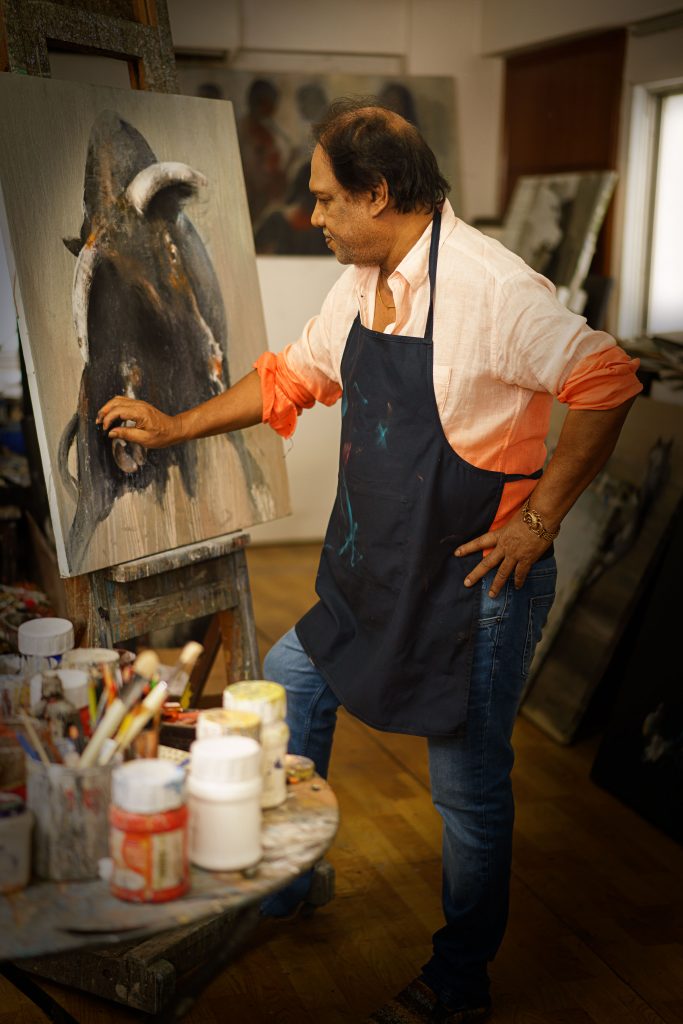
Auspicious beginnings
The Japanese have a concept called ‘ikigai’, which sits at that magical intersection between passion, purpose, and profit. It is loosely translated to one’s calling, although it is so much more. Some people spend half their lives searching for their ikigai, but according to Jamal Ahmed, who was born in 1955, he may have found it even before birth. “My mother would dry fish scales, paint them, and glue them together to make flowers. She played with many such interesting craft experiments while pregnant with me” he elaborates, with the implication that it may have created a natural affinity for art. He cannot remember a time when he wasn’t painting or drawing something. “I wasn’t that great at studies. The class toppers wouldn’t even notice me the rest of the time. But whenever it was time for the art exam, I became the hero” he remembers fondly.
Uncharacteristically for a South Asian family in the 60’s, Jamal Ahmed’s family supported his passion for art. Ahmed is one of nine brothers and sisters, and describes his whole family as being more or less cultural minded. As a young boy, a chance encounter with the artist Shahabuddin Ahmed added fuel to his desire to join the Art College, which is now known as the Faculty of Fine Arts, University of Dhaka. His father, probably (according to the artist) somewhat inspired by having met the great Zainul Abedin, acquiesced on the condition that he complete high school. So, with an SSC and an HSC from Government Laboratory High School under his belt, he officially began his foray into the world of arts in 1974.
A change in perspective
A look at Jamal Ahmed’s work on Artsy, an online gallery, shows sensuous paintings of women bathing in the river, horses splashing through water, pigeons cozying up to one another. Taking pride of place in the MWB headquarters, in fact, there is a large painting of a raging bull in all its glory. There is a dreamlike, kinetic quality to these paintings, a suggestion of movement even in the stillness, emotions conveyed through a few articulate strokes.
“God gives us gifts but if you do not nurture them, they will not grow to be anything significant.”
~ Jamal Uddin Ahmed
Ahmed talks us through the colourful evolution of his artistic talent. At Dhaka University, he learned to find artistic inspiration in everyday objects, guided by Shaheed Kabir. Rather than the classes, it was the addas with his teacher Mohammad Kibria that he developed a keen appreciation for imbuing art with emotions to make it come alive. The artist he references most often, however, was not a direct teacher, but a close personal friend who he looked up to, and that is – you guessed it – Shahabuddin Ahmed. Jamal Ahmed graduated from Dhaka University with an art degree under his belt, when he had another momentous encounter with Shahabuddin Ahmed, who had returned from Paris with a fire in his belly. “He said to me ‘Unless you learn to draw nudes, you’ll never be an artist!’ I was taken aback” Ahmed recalls, stating that at the time, finding the right kind of subject to do just that was hard to come by in culturally conservative Dhaka. So, it was off to Poland, where he did a two-year research course at the Academy of Fine Arts in Warsaw.
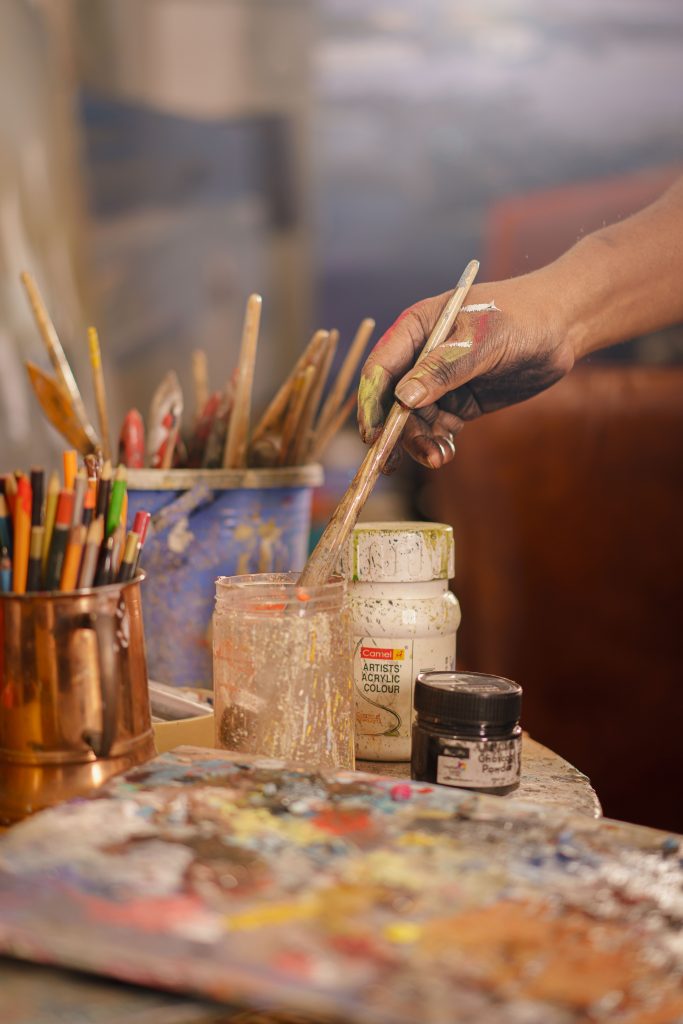
“I remember the first time we were going to do some anatomy illustrations. I was your typical red-blooded young man, excited and nervous at the prospect of being this close to a nude female, conjuring up images of the Polish beauties I had seen. To my great consternation, our first model was a senior, and when she disrobed in front of us, it was even more awkward for an inexperienced youth of my background. But once I had the paintbrush in my hand, all of it receded into background, and I got lost in the art.”
It was with these candid, self-deprecating jokes that the artist proceeded to illustrate with his words his growing maturity and confidence as an artist. As he learned to shed his inhibitions and give into artistic impressions, so too, did he bring in his own sensibilities into his craft, bringing in images from his homeland, familiar scenes from his youth, to create his signature style. It would still be a few more years before he became the Jamal Uddin Ahmed we know and revere today.
“Before you can break something, you have to learn how to build it first”
~ Jamal Uddin Ahmed
Passion and perfection
Our conversation with the artist had us relocate to a recently-opened Pan Asian fusion restaurant in Banani. One of the interior spaces in the establishment features an accent wall covered in overlapping glazed ceramic plates that have been screwed onto the wall. The total effect is that of multi-colored fish scales, which is something of a neat visual bookend to his earlier revelation about his mother’s craft experiments.
At this point, we’ve heard a lot of surprising, charming, and occasionally hilarious anecdotes from his storied life – Picasso-like encounters where he was short of cash and had to speed-sell some paintings; couples who surprised each other with Jamal Uddin Ahmed originals, and the artist himself was the only person in the know. All accounts of him being a rambunctious raconteur are true.
Jamal Ahmed is inspecting his bowl of miso soup and regaling us with his first encounter with this dish when he moved to Japan after his two-year stint in Poland, where he would study oil painting at the University of Tsukuba until 1984, eventually earning his post graduate degree from there in 1986. “I didn’t like the taste at all at first” he admitted. “But it eventually grew on me.”
What didn’t really grow on him was what he felt was the Japanese approach to art. “They are extremely hung up on technique, and precision and perfection” he elaborates. “Where is the passion? Where are the emotions? Where is the spontaneity?” This obsession with technique and aesthetics is the reason, in his opinion, that while Japan has certainly produced artists skilled with woodcuts and other art forms, there aren’t many painters of note from that region.
This is not to say that he hadn’t picked up valuable lessons on precision and perfection during his studies there. “When I went to Japan on a scholarship, I figured a technique combining Shahabuddin’s style with some Japanese form and then giving it a twist of my own” he had stated in a previously published interview.
Alchemizing his various experiences and discoveries, he has scaled his artistic visions up and down to great effect. His prize-winning miniatures performed well in the US in the 90’s, and in 1995, he completed a residency at the North Carolina State University. He has also worked on massive painting installations here in Bangladesh, the largest he can recall being a 5ftx27ft mural for Heritage Hotel.
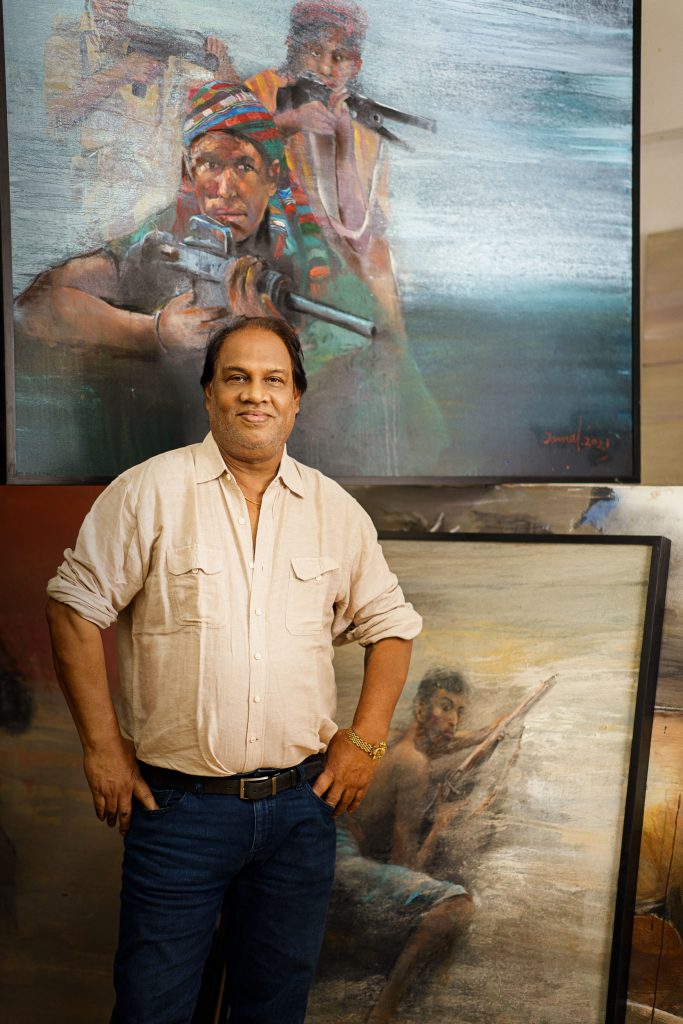
A happy medium
He has extensively researched oil paintings, but Jamal Ahmed prefers the speed and the excitement of watercolor and acrylics. In fact, he is considered the pioneer of acrylic art in Bangladesh, having been introduced to the medium during his Japan years in the 80’s. “Oil paintings require a lot of oil and thinner to achieve a certain fluidity. This costs a lot, makes a mess, and also takes a lot of time. The Japanese were starting to experiment more with acrylics around the time I was there, and when I realized you could just use water with acrylics, it was a big shift for me. These weren’t available in Dhaka yet, so I brought some back with me.”
The signature technique he is known for – the infusion of acrylic dust onto the malleable paint for added texture, was an innovation that happened quite by chance.
“I was cleaning my studio one day, and while rinsing out the water cup I use for diluting the paints, I noticed the acrylic residue at the bottom. All the various colours that had leached off my brush had formed this sediment, which had a very interesting shade. So, I scooped that up and applied that to my canvas and discovered that it creates an organic shade, exactly like the mud that collects at the riverbank. Visually, it already had the texture that I was trying to achieve through colour! So now I teach my students how to use this technique in their landscape paintings.”
And indeed, Jamal Ahmed, who has until recently been a faculty of the Fine Arts Institute, is known for promoting the works of the younger generation of artists. At various interviews, he has name-checked former students or junior colleagues he wants you to pay attention to. At the same time, he is a firm believer in investing time and gaining experience in one’s craft. He gets animated in explaining the importance of being on-site, and close to the subject, instead of always relying on reference photos. “You could spend a lot of time copying a reference photo, and maybe even get a perfect replica, but you will miss out on the essence of your subject if you don’t get close to it at least once” he advises. “Perfection is pretty to look at, but it is emotion that makes it art.”
As charmed as he is by the wealth of tools available at an artist’s disposal today, and the power of social media to promote artists, he feels that the downside to all this abundance is that younger entrants into this world no longer have the patience to hone their craft.
“Everyone wants to become rich and successful overnight,” he says. “Everyone wants to become Shahabuddin or Jamal Uddin, without putting in the time and effort that Shahabuddin or Jamal Uddin did in getting where we have today. I tell the younger generation that I too, started with very little, and had to struggle a lot before success started coming my way. You can push sell a few paintings, and maybe your uncle may buy one, or your friends, but if you really want longevity in this industry, there is no shortcut.” He goes on to clarify that he isn’t against newbie artists publishing or exhibiting their work; if anything, he encourages it. “If you can actually sell a few paintings, you get the onus to continue, because art supplies are expensive. It takes money to sustain this lifestyle.”
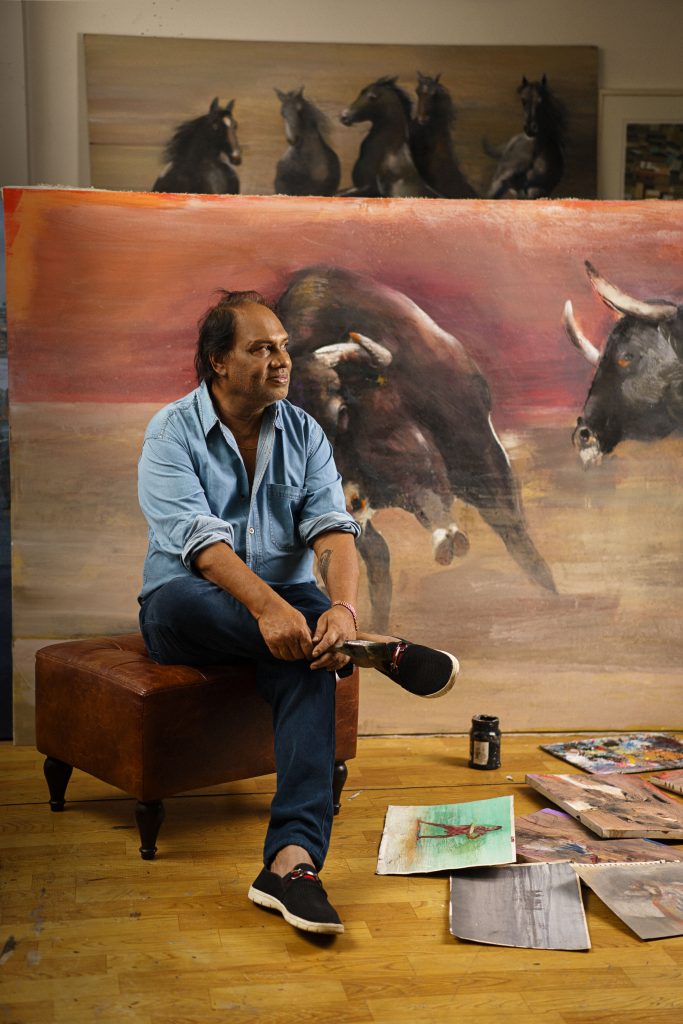
The way forward
Life changed for everyone in 2020, Jamal Ahmed included. “My initial fears were similar to everyone else’s,” he admits, listing health and finances being major concerns. His art from those initial fear-filled days feature masked faces, in keeping with the prevailing zeitgeist.
Like a few of his notable peers, Jamal Ahmed donated some fifteen paintings to the Artist Association, each priced at about Tk20-30,000, and about eight of them have already been sold. The proceeds from the sales went to a fund for younger artists suffering financial losses during the pandemic. Ahmed also stated that the government, and Shilpakala Academy, have both provided financial assistance to struggling artists.
“I’m not sure why, but we noticed that a lot of people spent a lot of money buying art during the pandemic. Maybe their priorities changed, or they desperately needed something to cheer them up during lockdown, but there was a surprisingly high demand for art” he tells us.
Recalling his wild and wonderful journey, Ahmed expresses his deep debt of gratitude to the art education he received, from early school days to the Dhaka University days, and beyond, and stresses the need for investment in art education. “If (Zainul) Abedin Sir hadn’t taken the initiative to start the Fine Arts Institute, art education would have remained the purview of only the richest kids, who would go abroad to get it. I don’t know if I could have managed to go abroad” he confesses. He believes there should be a bigger investment in art in mainstream schooling. “Schools abroad teach everything, from painting, to wood cutting. Children end up with a lot of useful skills.”
After many, many wild and wonderful stories, going back and forth in time, covering everything from memorable encounters to spicy gossip from the art scene, we parted ways, richer for the experience, but also knowing, we had just scratched the surface.
On the cover: Jamal Uddin Ahmed
Photographer: Rafiqul Islam Raf
Fashion Editor: Mahmudul HAsan Mukul
Make up & Hair: Aura Beauty Lounge




